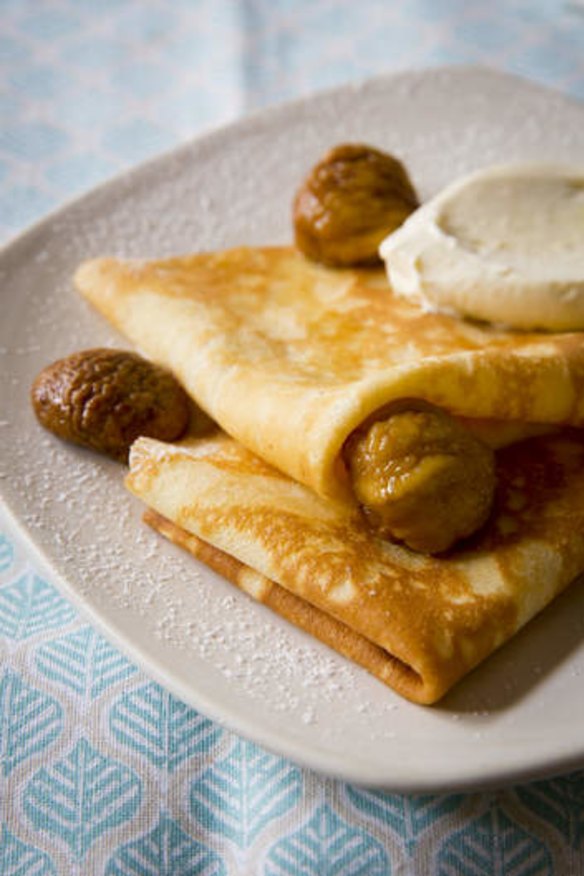Frank Camorra's crepes with vanilla chestnuts and orange cream
As the weather cools, transform chestnuts into a sweet surprise.

Just before their leaves turn the countryside a piercing shade of burnt orange, the chestnut trees in Spain release their nuts. From inside a coarse, prickly case, a few shiny chestnuts emerge. It is the last real crop of abundance before winter. Walk the streets of Spain when the air begins to chill and there is a constant fragrant note - the aroma of chestnuts roasting.
Fast street food is fun and keeps the hands warm, but chestnuts are serious business in Spain. Prior to the arrival of potatoes they were the main source of winter starch, and to this day the Galicians still make a soup of chestnuts and pork.
This vanilla chestnut recipe creates a lovely aromatic syrup that can be enjoyed on French toast or with ice-cream. When peeling the chestnuts, the hotter you keep them the easier it will be to get the furry inner layer off. It cools down very quickly and sticks to the nut.
Crepes with vanilla chestnuts and orange cream
60g unsalted butter
3/4 cup full-cream milk
3 large eggs
1 cup plain flour
¼ tsp salt
2 tbsp sugar
180ml heavy cream
1 orange
30 chestnuts in syrup (see recipe below)
icing sugar, to dust
Melt three tablespoons of the butter in a well-seasoned crepe pan or a 20-centimetre non-stick skillet. Blend the milk, eggs, flour, salt, and sugar in a blender until smooth. Pour in the melted butter, leaving a film of butter in the skillet, and blend until well combined. Heat the skillet over moderately high heat until hot but not smoking. Half fill a ¼-cup measure with batter and, holding the skillet off the heat, pour in the batter, immediately swirling and tilting the skillet to create a thin, even layer. Return the skillet to heat and cook until crepe is golden around the edges and dry in the centre. This should take about 45 seconds. Flip the crepe carefully and cook until golden, about 15 seconds more. Using the remaining butter, make more crepes with the batter, stacking them as cooked. Put the cream in a bowl and grate the zest from the orange into the bowl so the oils from the orange spray into the cream. Whip the cream to soft peak. Fold the warm crepes into triangles and put on a plate. Arrange five chestnuts on the plate with a little syrup and a scoop of cream. Finish with a shake of icing sugar.
Serves 6
Chestnuts in syrup
1.8kg fresh chestnuts
500g castor sugar
2 lemons
1 vanilla bean
Take each chestnut and, using a small, sharp knife, make cross-shaped incisions in their flat sides. Bring a large saucepan of water to the boil and blanch the chestnuts for three minutes. Remove from heat and leave the chestnuts in the water. Using the blade of the knife, remove outer skin. Remove the inner skin using a knife, or wipe it off with a clean cloth (the ease of removing the skin depends on the age and variety of chestnut). Discard skins. Put the sugar in a large saucepan with 1 litre of water. Using a vegetable peeler, peel lemon zest from the lemons in wide strips and add it to the pan. Cut the vanilla bean in half lengthways, then scrape the seeds into the pan and discard the vanilla bean. Bring the liquid to the boil over a high heat and cook for five minutes. Add peeled chestnuts. When the liquid starts to boil again, reduce heat to medium and simmer for 20 minutes. Meanwhile, wash and sterilise two 1-litre preserving jars, lids and seals. Making sure the jars are still very warm, remove the chestnuts from heat and transfer to the jars using a sterilised slotted spoon, filling the jars evenly. Pour in syrup and seal while hot. Allow to cool, then store in a cool, dry place for up to three months. Once opened, the chestnuts will keep, refrigerated, for two to three weeks.
Makes two 1-litre jars.
FRANK'S TIP
Buy the best-quality chestnuts; lesser-quality nuts will taste grainy and will not cook well in the syrup. Look for smaller rather than large chestnuts.
The best recipes from Australia's leading chefs straight to your inbox.
Sign up